University of Pune 2009-2nd Sem B.E Biotechnology T.E. s - Question Paper
Illllllllllllllllllll [3563] - 266
T.E. (Bio Technology) (Semester - II) Examination, 2009 COMPUTATIONAL TECHNIQUES AND PROCESS MODELING (2003 Course)
Time : 3 Hours Max. Marks : 100
Instructions x I) Figures to the right indicate full marks.
2) Use of Programmable calculator is not allowed.
3) Draw a neat sketch wherever necessary.
4) Make necessary assumptions wherever required.
5) Answer any three questions from Section I and any three questions from Section II.
SECTION - I
1. a) Find the Eigen values and Eigen vectors of
r \ -5 6
-3 8 9 3 4-7
b) Determine the values of x for which the following set of equations may posssess non-trivial solution. 6
3x1 + XP - xx3 a 0,
4xi - 2x2 - 3xq a 0,
xI + 4x2 + xx3 a 0.
c) Given matrix
f 1 2 2
-6 -1 2 6 2-1
A =
Find the values of Eigen values of A. Find the Eigen values of A 1. OR
2. a) Find the characteristic root and the characteristic vectors of the matrix
1 3 5
7 9 11
A =
v13 15 17y
b) Find the values of x, y, and z by using Guass Siedal method 7x + 2y + 2z a 0
- 6x - y + 2z a 0 6x + 2y - z a 0
c) Find the values of % for which the equations @2 - X) x + 2y + 3 a 0
2x + @4 - X )y + 7 a o 2x + 5y + @6 - X) a 0
are consistent and find the values of x and y corresponding to each of these values of .
3. a) Fit a second degree Parabola to the following data of the form y a ax2 + bx + c.
|
X |
1 |
2 |
3 |
4 |
5 |
6 |
7 |
8 |
9 |
|
Y |
2 |
6 |
7 |
8 |
10 |
11 |
12 |
14 |
16 |
b) By using Newton Raphson method, find the real root of l/V2S. 6
c) Solve by using Eulers method 6 Y1 a x + y2 and y a I at x a 0. Find an appropriate value of y at x a I.
OR
4. a) Using Modified Eulers method find the real root of 6
Y1 a x + y and y a 1 when x a 0 take h a 0.1
b) Evaluate by using Trapezoidal rule. 6
|
X |
0 |
1 |
2 |
3 |
4 |
5 |
6 |
|
F(x) |
1 |
0.5 |
0.2 |
0.1 |
0.058 |
0.038 |
0.027 |
c) A train is having the following velocity Vs time distribution. The velocity and time are related by v a tb. Find the values of a and b.
|
V (ft/min) |
350 |
400 |
500 |
600 |
|
T(min) |
61 |
26 |
7 |
2.6 |
5. a) Evaluate 2Cos2x. 4
b) Assuming that the following values of y belong to a polynomial of degree compute the next three values. 8
|
X |
0 |
1 |
2 |
3 |
4 |
5 |
6 |
7 |
|
Y |
1 |
-1 |
1 |
-1 |
1 |
- |
- |
- |
|
c) Estimate the values of f(33) and f(24) from the following data | ||||||||||||
| ||||||||||||
|
OR |
6. a) Give d1 a 40, dp a 45, dQ a 54, find dp, dR and d6.
4
6
b) Explain the terms
i) Finite differences
ii) Argument
iii) Leading term
iv) Leading differences
v) Forward difference operator
vi) Interpolation techniques.
c) Find the Polynomial which takes the following values :
|
X |
0 |
1 |
2 |
3 |
|
F(x) |
1 |
4 |
6 |
10 |
SECTION - II
7. a) Obtain the modeling equations for a two phase CSTR with heat removal. 8
b) What are the types of equilibria encountered in Process modeling ? Explain
them in detail ? 8
OR
8. a) A perfectly mixed isothermal CSTR has an outlet weir. The flow rate over the
weir is proportional to the height of the liquid over the weir how to 1.5th power.
The weir height is hw. Cross-sectional area of the tank is A assume constant density. A first order reaction A -> B takes place in the tank. Show that the system is critically specified. 8
b) Derive the modeling equations for a Batch distillation column ? 8
9. Derive the temperature distribution along a packed column with simultaneous heat transfer. 16
OR
10. a) Derive the modeling equations for a chemical reaction occurring in a tubular
reactor with simultaneous mass transfer. 16
11. a) Give a detailed description with a neat sketch about the following : 10
i) Suspended growth reactors
ii) Attached growth reactors.
b) Explain the modeling of ethanol fermentation in a batch large scale reactor. 8 OR
12. What are chemostats ? How modeling is done for substrate growth in chemostats ? 18
T.E. (Bio Technology) (Sem. - II) Examination, 2009 INSTRUMENTATION AND PROCESS CONTROL (2003 Course)
Time: 3 Hours Total Marks: 100
Instructions x I) Figures to the right indicate full marks.
2) Use of Programmable calculator is not allowed.
3) Draw a neat sketch wherever necessary.
4) Make necessary assumptions wherever required.
5) Answer any three questions from Section - I and any three questions from Section - II.
SECTION - I
1. a) What do you mean by Process Control ? What is the need for control
measurement ? 4
b) Write short notes on Temperature control elements. Where do you find them in Industrial applications ? 6
c) How do you measure the diffusivity of gases by using process control equipments ? 6
OR
2. a) Write short notes on resistant thermometer with a neat sketch. 6
b) Define hot wire ammo meter and explain the flow measurement by hot wire ammo meter. 6
c) Explain the terms : 4
i) Shadow graphs
ii) Optical pyrometer
3. a) The pump removes water at a constant rate of 10 Cfm, this rate is dependent on head. The cross sectional area of the tank is 1Ft1 and the resistance R is 0.5 Ft/Cfm.
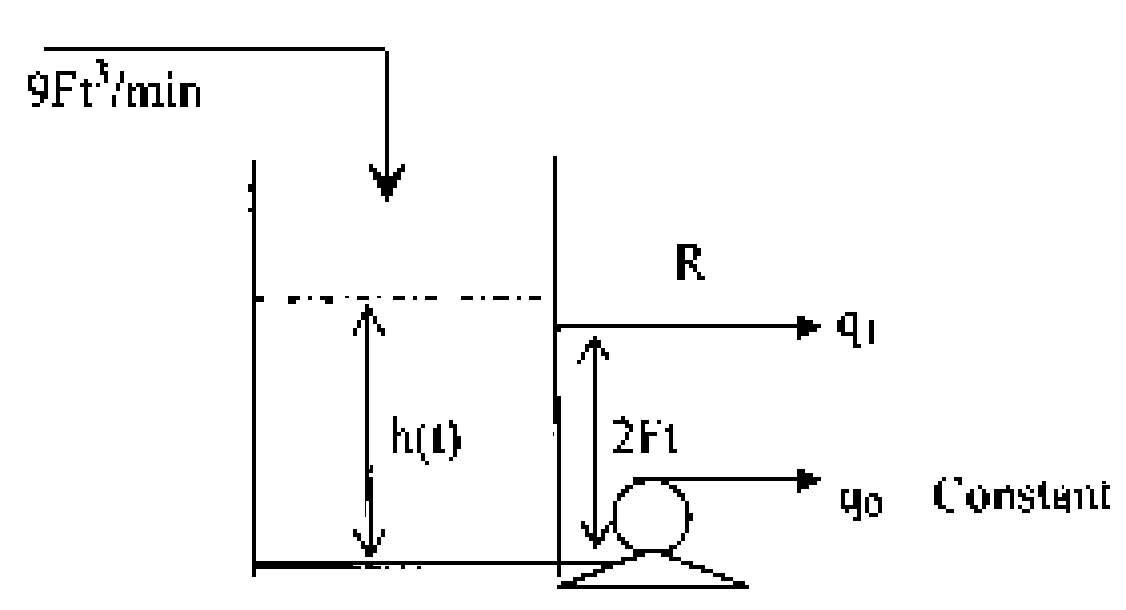
b) Define a non interacting system and obtain the Transfer function of a non interacting system.
c) A tank having a cross sectional area of Ft2 is operating at steady state with an inlet flow rate of 2 Cfm. The flow head characteristics are shown in Fig.
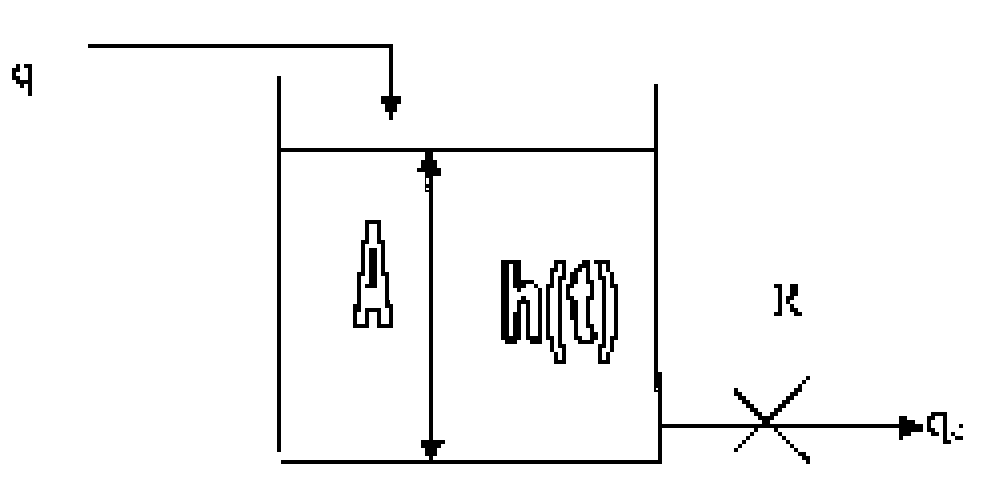
b) Derive the Transfer function H/Q for the liquid level system shown in Fig. The resistances are linear. H and Q are deviation variables. 6
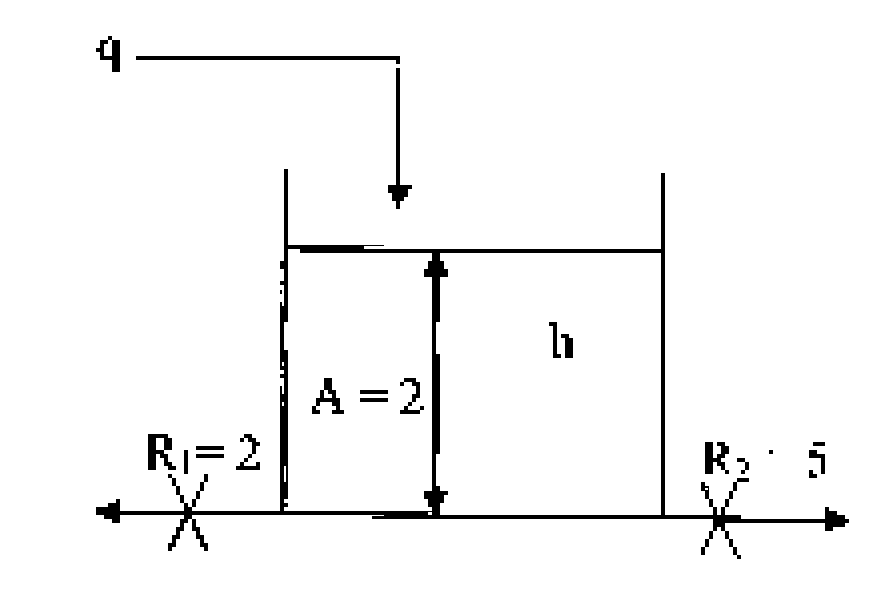
c) Derive the Transfer function of an interacting system for which %l = %2 = % and Aj a a2 with a neat sketch. 6
5. a) Explain negative feedback system with a neat sketch. 4
b) Define in brief : 6
i) ON - OFF controller
ii) PID controller
List out the advantages and limitations of each control action.
c) In control system in Fig, find the value of Kc for which the system is on the verge of instability. The controller is replaced by PD controller, if Kc= 10
determine the range of % for which the system is stable. 8
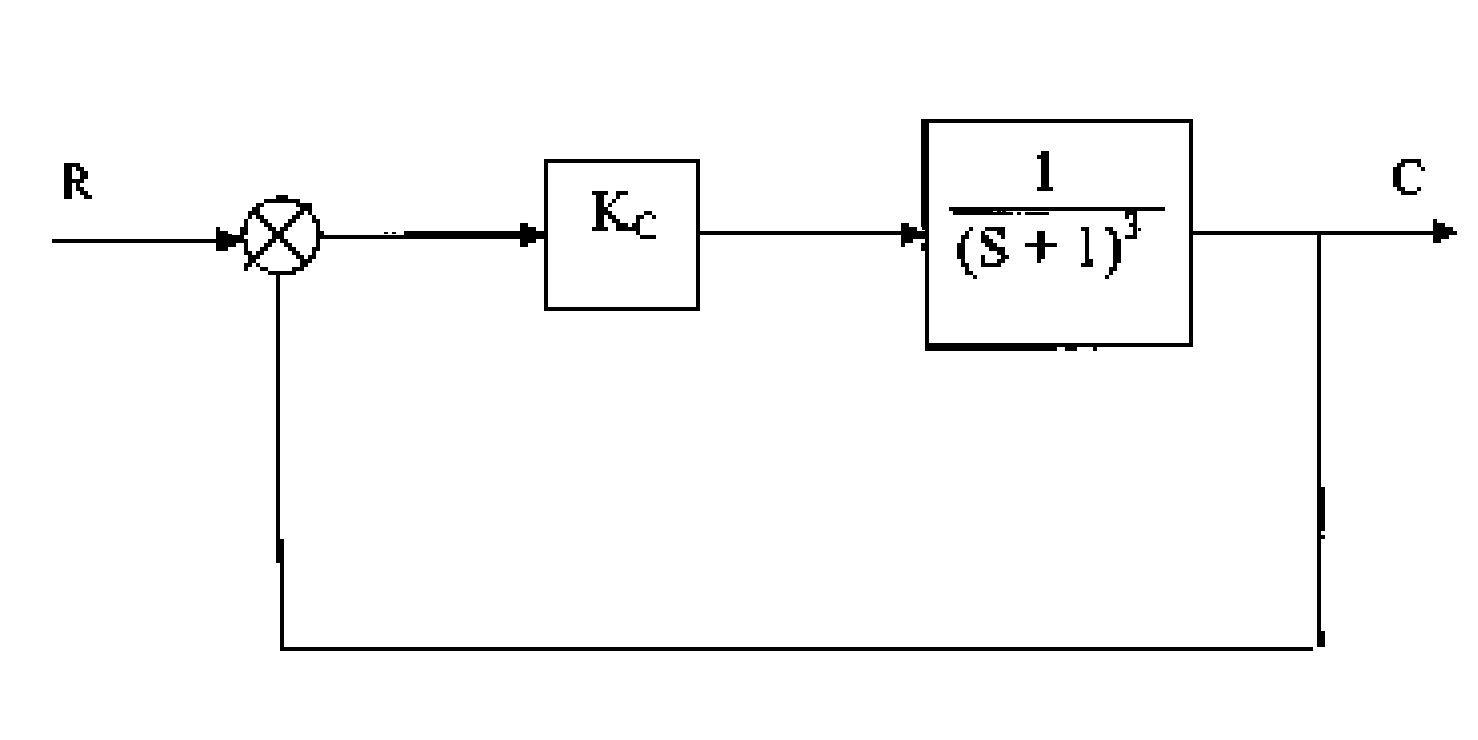 |
|
OR |
6. a) Explain the terms :
i) Control valve with a neat sketch
ii) Saturation of a control valve
iii) Angle criterion
iv) Stability criterion.
b) Sketch the Root loci for the equation
K
G =
(S + l)(S + 2)(S + 3)
c) Determine the Transfer function C/R for the system shown in the Fig.
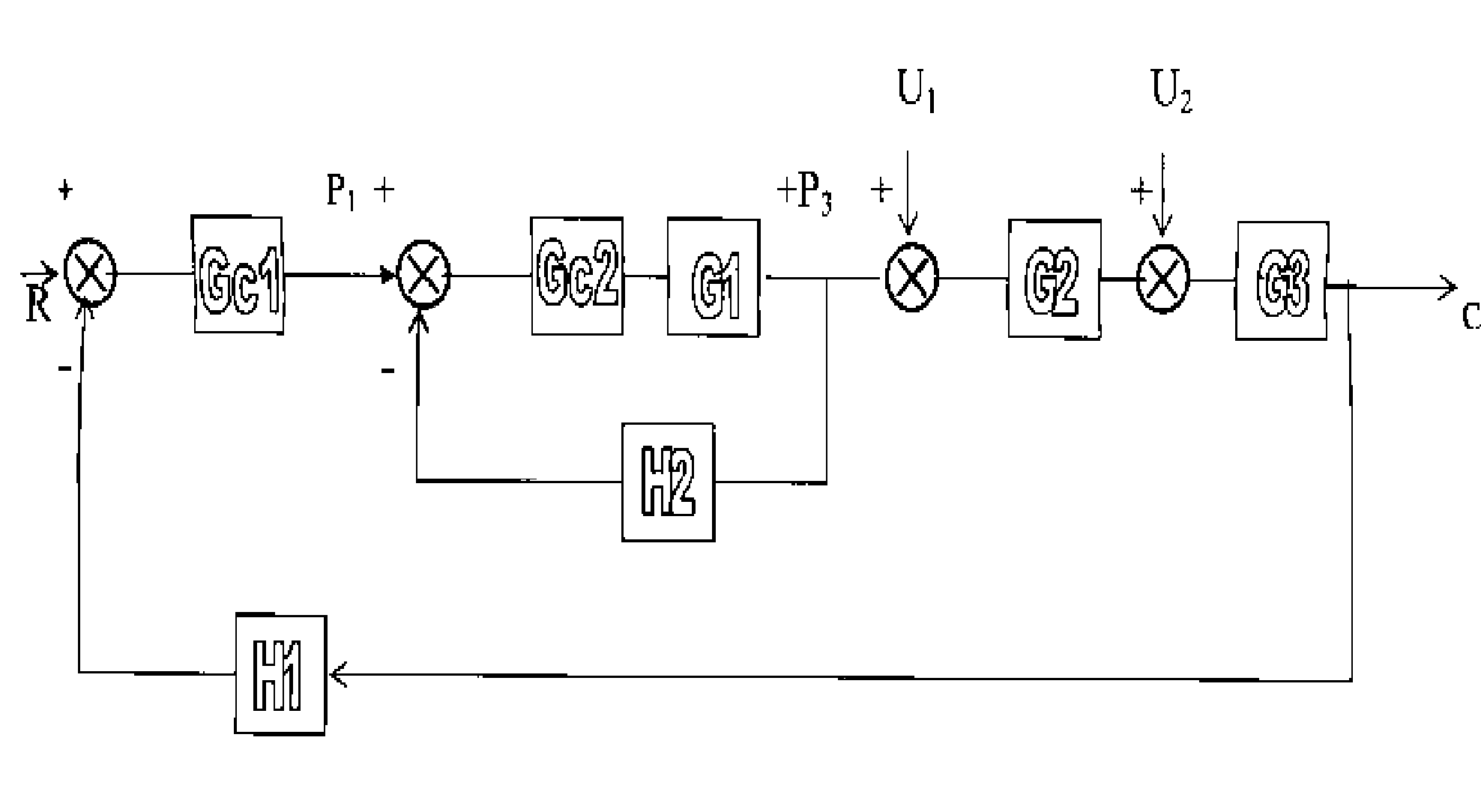
d) Define the terms :
i) Unity feedback
ii) Offset.
7. a) Explain the terms :
i) Poles and zeros of a Transfer function
4
ii) Breakaway point
iii) Asymptotes
iv) Angle of departure.
b) What are tuning rules ? Explain Ziegler Nichols rules in detail.
Tabulate Ziegler-Nichols Controller settings. 6
c) Plot the Bode diagram for open loop Transfer function of the control system.
Write the domain values of AR and (J) for each unit. 6
10(0.5S + l)e-s/1 (S + 1)2(0.1S + 1)
OR
8. a) Define the following terms :
4
i) Bode stability criterion
ii) Nyquist stability criterion
iii) Frequency testing
iv) Sine wave generator.
b) What are the criteria for good control ? Explain
4
i) ISE
ii) IAE
iii) ITAE
c) The location of a load change in a control loop may affect the system response.
In the block diagram shown, a unit step change in load enters at either location I and load enters location 2. 8
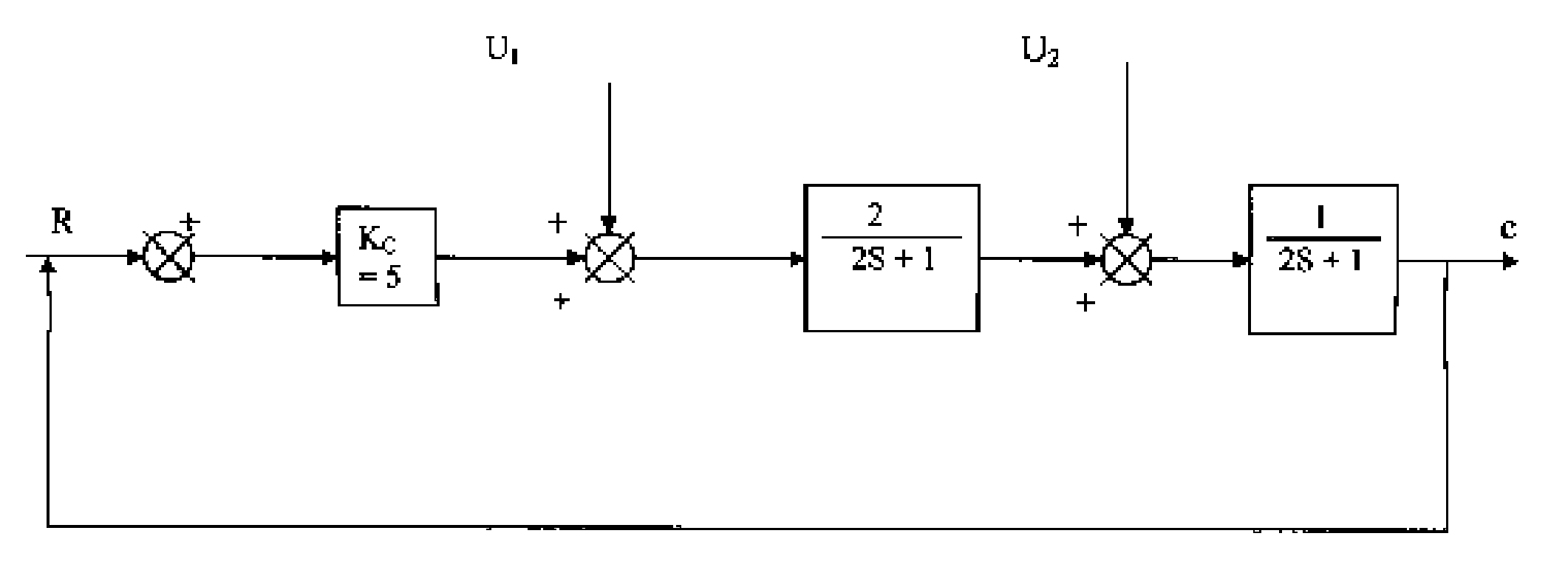
i) What is the frequency of the transient response when load enters at location 2 ?
ii) What is offset when the load enters at location I and 2 ?
9. a) Define the terms : 6
i) Ratio control
ii) Dead time compensation
iii) Applications of cascade control.
b) Explain with neat sketch Feed Forward Control.
4
6
4
6
c) Explain in detail with a neat sketch cascade control of a jacketed kettle. OR
10. a) Analyze in detail Feedforward control.
b) Explain the tuning rules for Feedforward control.
c) Write down the procedure for implementing Smith Predictor Control.
11. a) Define the terms 4
i) Neural networks
ii) Fuzzy logic.
b) Derive the process modeling equation for controlling the temperature in a Double pipe heat exchanger. 10
c) Define Network training. Explain the different ways of ANN learning. 4
OR
12. a) Write a short note on on-line measurement of Biomass with neat sketches. 6
b) Explain Black box principle. Explain the structure of simple ANN with a neat sketch and explain the functions of different layers of2ANN. 6
c) Explain the terms : 6
i) Adaptive control approach
ii) Expert control approach.
T.E. Biotechnology (Semester - II) Examination, 2009 IMMUNOLOGY (2003 Course)
Time : 3 Hours Max. Marks : 100
N.B. : i) Answers to the two Sections should be written in separate answer books.
ii) Draw diagrams neatly wherever necessary.
iii) Figures to the right indicate full marks.
SECTION - I
1. a) With the help of labeled diagram describe the structure of immunoglobulin
molecule. 9
b) Discuss the functional role of different classes of antibody. 9
OR
a) Discuss the mechanisms of innate immunity. 9
b) Enlist the primary, secondary and tertiary organs of immune system and describe
in brief any two organs. 9
2. What is an antigen ? Discuss the factors affecting immunogenicity of molecules. 16
OR
Giving reason describe the appropriate assay method used for the detection of following antigens/antibodies. 16
a) Insulin in serum
b) Syphilis spirochete in a smear from chancre
c) CD4 cells
d) HBs antigen in serum
3. Write short notes on any 4 of the following @4 marks each) : 16
a) T cell activation
b) APCs
c) Inflammation
d) Hybridoma technology
e) Class I and II MHC molecules
f) Adjuvants
g) How can you determine if two different inbred mouse strains have identical MHC haplotypes ?
SECTION - II
4. What is anaphylaxis ? Explain the role of IgE in Type I hypersensitivity reactions. 18
OR
a) Describe membrane attack complex formation of complement activation. 10
b) With the help of diagram explain CTL mediated pore formation in target cell membranes. 8
5. a) Enlist different types of vaccines and discuss the advantages and disadvantages. 8
b) What is primary and secondary immune response ? How does it help in vaccine
development ? 8
OR
a) What is active and passive immunization ? 8
b) Write a note on polio vaccine. 8
6. Write notes on any four of the following @4 marks each) : 16
e) Hashimotos Thyroiditis
f) Cytokines
g) Tumor antigens
h) Blocking auto-antibodies
i) Ghon complexes
j) Acquired Immuno-Deficiency Syndrome k) Antigenic drift
l) Interferon.
T.E. (Biotechnology) (Sem. - I) Examination, 2009 INDUSTRIAL MICROBIOLOGY (2003 Course)
Time : 3 Hours Total Marks : 100
SECTION - I
1. Discuss various techniques involved in improvement of industrially important strain. 18
OR
1. What is primary screening ? Discuss various methods in context of case study. 18
2. Highlight how alcoholic beverages production is different from alcohol fermentation ? 16
OR
2. Write in detail Glycerol fermentation process. Give details of chemical reactions leading to glycerol from sucrose glucose. 16
3. Discuss in detail citric acid production process. 16
SECTION - II
4. What are antibacterial antibiotics ? Discuss production process for Streptomycin. 18
OR
4. Write short notes on : 18
1) Saccharifying agents.
2) Microbial production B12.
5. Industrially important enzymes. Discuss one of them in detail. 16
OR
5. How immobilised enzymes are different in their application compared to naturally occurring enzymes ? 16
6. Write short notes on : 16
1) Fermentation efficiency.
2) Important features of fermentation costing.
OR
6. What is fermentation economics ? What parameters are required to be considered while designing economically viable fermentation product ? 16
B/I/09/110
T.E. (Biotechnology) (Sem. - I) Examination, 2009 BIOSEPARATIONS (2003 Course)
Max. Marks : 100
Time : 3 Hours
N.B.: i) Answer three questions from Section - I and three questions from Section - II.
ii) Answers to the two Sections should be written in separate answer books.
iii) Neat diagrams must be drawn wherever necessary.
iv) Figures to the right indicate full marks.
SECTION - I
1. a) Describe the need for bioseparation. State various types of cell wall. b) Discuss in detail various mechanical methods of cell disruption.
6
10
(4 each)
OR
2. Write short notes on :
a) Osmosis.
b) Extraction.
c) Ultrasonication.
d) Enzymatic Cell Lysis.
(8 each)
3. Give an account of :
a) Gas chromatography.
b) Paper chromatography.
OR
5. What are two major methods of filtration ? Elucidate various techniques of cross flow filtration. Mention one application of each technique. 18
OR
6. Write short notes on @6 marks each) : 18
a) Sedimentation.
b) Reverse Osmosis.
c) Gradient Centrifugation.
SECTION - II
7. Discuss the role of bioseparation techniques in Bioprocess engineering. 16
OR
8. Which compounds are classified as small biomolecules ? Write about secondary metabolites. 16
T.E. (Biotechnology) (Semester - I) Examination, 2009 BIOCHEMISTRY - II (2003 Course)
Time : 3 Hours Max. Marks : 100
1. Answer the following @9 marks each) : 18
A) Explain the tertiary structure of protein with example of myoglobin.
B) State the difference between isozymes-multienzyme and competitive,
non-competitive inhibition.
OR
2. The following data were recorded for the enzyme catalyzed reactions S P. 18
|
Sr. No. |
[S] (M) |
V mmoles x liter-1 x min-1 |
|
1 |
13.0 | |
|
2 |
5.50x105 |
54.25 |
|
3 |
8.00X10-4 |
58 |
|
4 |
8.00x103 |
72.9 |
|
5 |
8.00x102 |
73.0 |
Estimate Vmax and Km.
3. Explain the role of coenzyme A as acyl group carrier. 16
OR
4. Explain the reaction mechanism of pyruvate dehydrogenase and the role of TPP as
a catalytic cofactor. 16
7. Write in detail about (9 marks each) : 18
A) Structure function correlation in case of protein.
B) Alpha helix, beta pleated sheet.
OR
8. Write in detail (9 marks each) : 18
A) Structure and function of nucleic acids.
B) Secondary structure of protein.
9. Explain the following (8 marks each) : 16
A) Functioning of cyt. P450 in drug metabolism.
B) Na/K pump.
OR
10. Answer the following (8 marks each) : 16
A) Role of Ca++ in muscle contraction.
B) Functions of any two endocrine hormones.
11. Write in brief (4 marks each) : 16
A) What is the deficiency of vit. Bi called, its types and symptoms ?
B) Role of iron in the body and its dietary sources.
C) Tests used for monitoring cardiac dysfunction.
D) Metabolism of branch amino acids in the body.
OR
12. Answer the following (8 marks each) : 16
A) What is the significance of gluconeogenesis ?
B) The process of ketogenesis and its significance.
B/I/09/110
i) Over shoot
ii) Response time
iii) Period of oscillation
iv) Natural period of oscillation.
Answer the following @8 marks each) : 16
A) Explain the different kinds of receptors.
B) Write in brief about NF-kappa b and cannabinoid receptor. p T O
|
Attachment: |
| Earning: Approval pending. |
